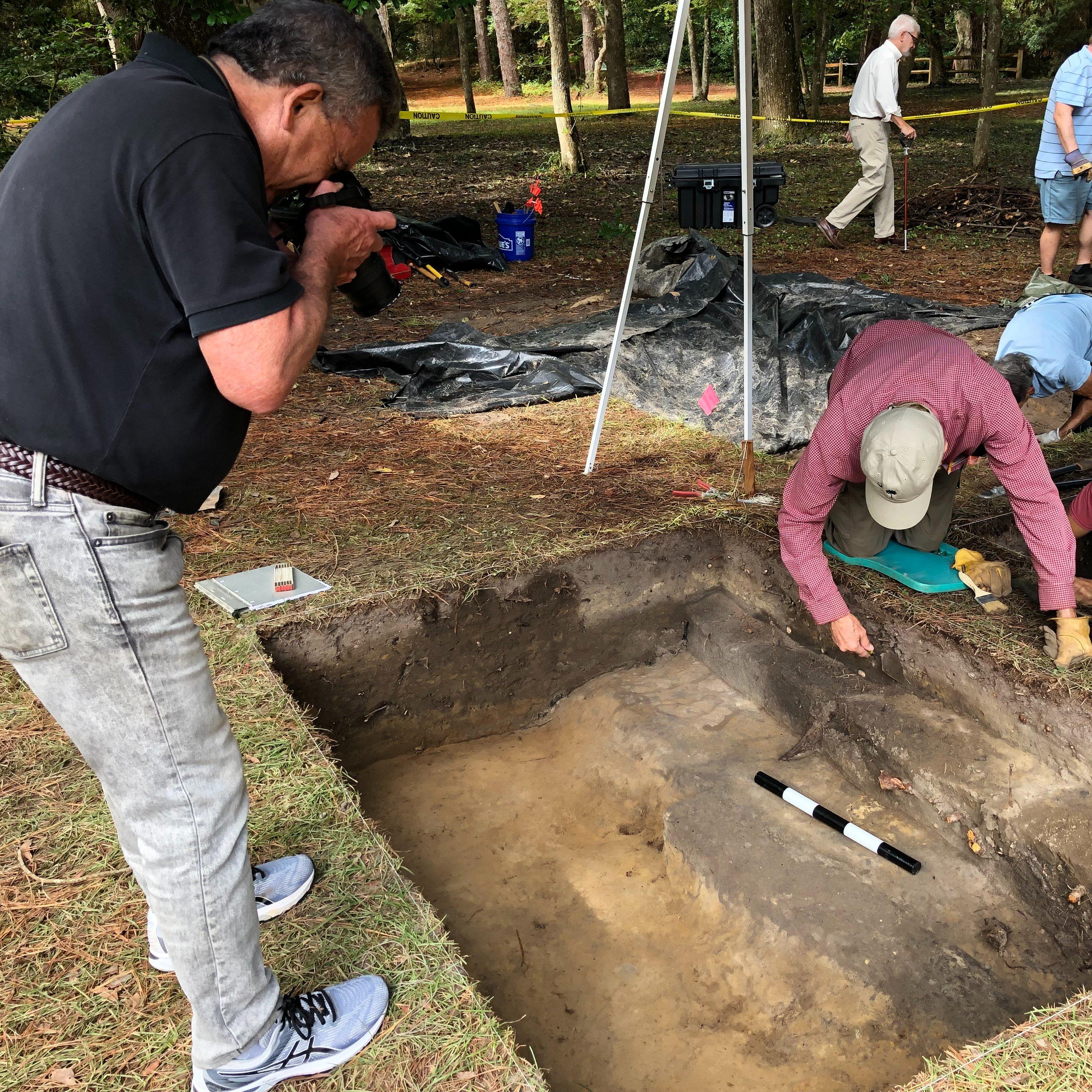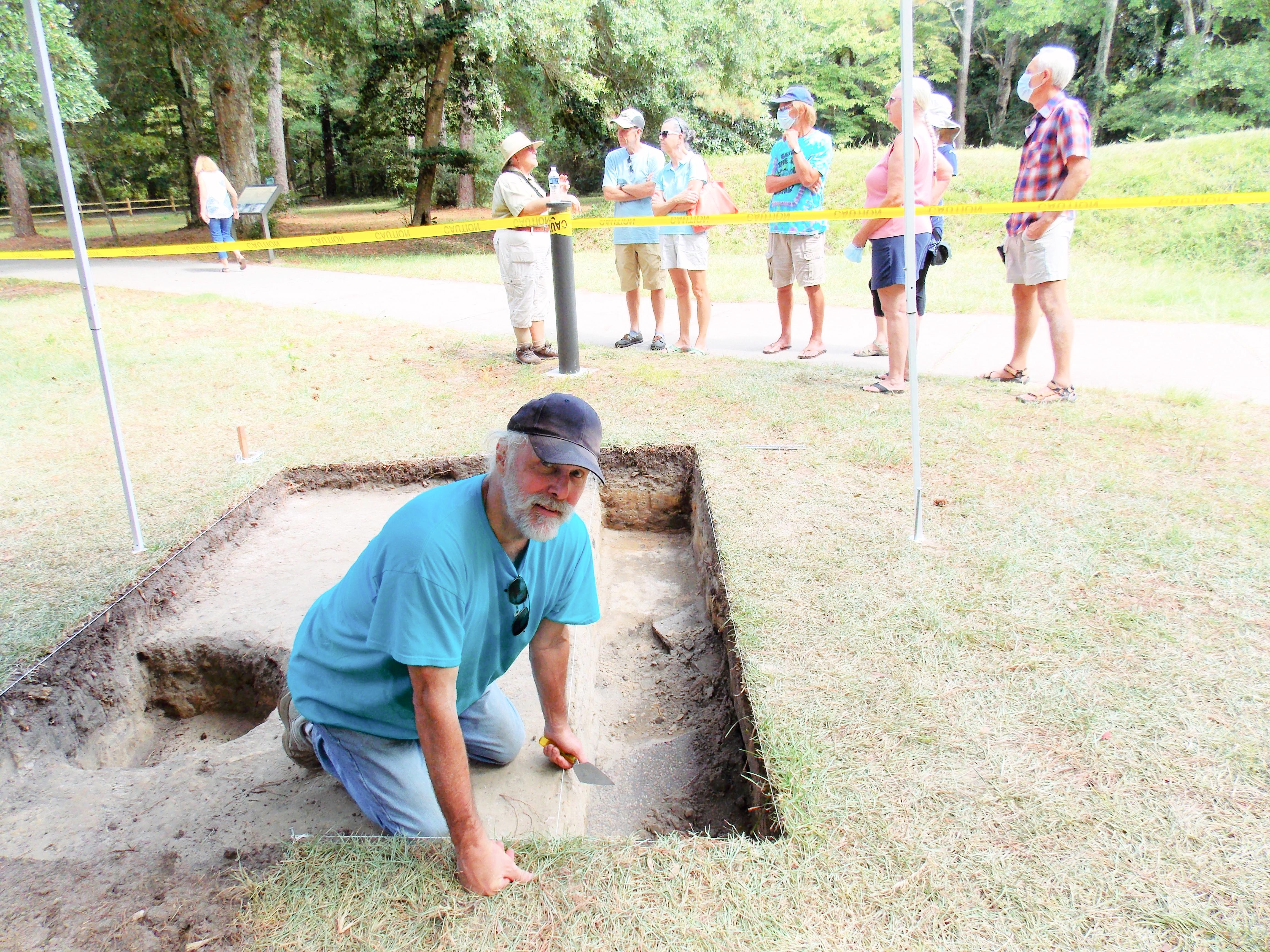
Ongoing excavations at Fort Raleigh yield clues to the lives and work of the Roanoke Island colonists. / NPS
Lost And Found
Archaeology holds the answers to many enduring questions about the Roanoke Island colonists.
By Kim O’Connell
“Let me ask you a question,” Jack Currie, an NPS volunteer interpreter at Fort Raleigh National Historic Site, says to a group of park visitors. “How many times would you have gone down to the beach to look for a sail on the horizon?”
He’s talking about the famous Lost Colony, part of Sir Walter Raleigh’s efforts to establish a permanent English settlement in America more than 435 years ago. Left behind on Roanoke Island on North Carolina’s Outer Banks in 1587, the colony of nearly 120 English men, women, and children is at the center of one of the most confounding and enduring mysteries in American history. The colony's governor, John White, had returned to England for more provisions when he was delayed by the Anglo-Spanish War. When he finally returned in 1590, the colony had vanished.
Today, archaeologists are working to uncover artifacts and evidence that shed light on the colonists’ lives on Roanoke Island. Although solving the mystery of the Lost Colony is a perennial goal, this work is primarily focused on uncovering details about the colony that will help shape how the National Park Service interprets this complex cultural site.

A map of the Outer Banks, including Roanoke Island, drawn by colonial governor John White around the time of the expeditions. / The Trustees of the British Museum
“It’s one of the most complicated small sites you can imagine,” says Dr. Eric Klingelhofer, vice president of research for the First Colony Foundation, a nonprofit organization he cofounded that partners with NPS to conduct research and archaeology at Fort Raleigh. “We have had several phases of occupation and activity on that site. Colonists were digging trenches in the same area, but for different purposes, over the five years or so they were there. It’s a very difficult site, it’s got electrical cables underground, and it was a state park before it was a national park.”
Despite the challenging location, archaeologists have found what they believe is solid evidence that Roanoke Island was not just a place for settlement in the late 1500s, but also for science.
Multiple Layers And Unknowns
Nestled between the mainland and the outlying barrier islands of the Outer Banks, Roanoke Island is a quiet, forested landscape that feels altogether different from the windswept dunes and wide beaches of nearby Cape Hatteras National Seashore or the bustling beach towns of Nags Head and Kitty Hawk, home to the Wright Brothers National Memorial (all three parks are managed together in what NPS calls the "Outer Banks group"). The island had been occupied by Algonquian-speaking Indigenous people when Raleigh’s first expedition, led by Ralph Lane, landed there in 1585.
Queen Elizabeth I had issued a charter allowing Raleigh, an explorer and writer who'd won favor with the queen, to “discover, search, find out, and view such remote heathen and barbarous Lands, Countries, and territories…to have, hold, occupy, and enjoy.”
The 1587 expedition departed England on May 8 and landed on Roanoke on July 25, to establish the “cittie of Raleigh” in what the English were calling “Virginia.”
No one knows whether it was a single calamitous event, or a series of smaller misfortunes, that led the colonists to abandon the site, but when Governor White returned to the colony in 1590 he found that the colonists had dismantled their houses and taken whatever they could carry. The only clues to their destination were the letters “CRO” carved into a tree and the full word “Croatoan” carved into a post. White assumed this meant that the colony had moved to Croatoan Island (present-day Hatteras Island), which they may well have done, but subsequent searches turned up no survivors or confirmed descendants. Prevailing theories are that they assimilated into an Indigenous tribe, perished at sea, or were killed in an attack or conflict.
Fort Raleigh National Historic Site was added to the National Park System in 1941, four years after an outdoor drama called The Lost Colony began performances at the Waterside Theatre on the site. Through a cooperative agreement, the play continues to be performed there to this day. The park now interprets several eras of history, from the lives of the Algonquians to the Roanoke expeditions to the establishment of a freedmen’s colony there during and after the Civil War.
But the mysterious Lost Colony is by far the largest draw. Thanks to recent archaeology, the environment they lived in has become better understood.
A Clearer Picture Emerges
In the fall of 2021, as the Carolina sun beat down, a group of archaeologists—some professionals, some interested volunteers—were bent over rectangular pits, digging, dusting, and digging some more. Led by Dr. Klingelhofer and others from the First Colony Foundation, the teams were examining a section of land near a reconstructed earthwork that dates to the 1950s, one of the park’s most popular destinations. Previous archaeology work had uncovered evidence of a metallurgical and science workshop set up during the first Roanoke expedition by German metallurgist Joachim Gans and English scientist Thomas Harriot. Gans is known for being the first Jewish person in North America, and the Oxford-trained Harriot, an astronomer, mathematician, and mapmaker, would later publish a book titled The Briefe and True Report of the New Found Land of Virginia.
Archaeologists found significant artifacts supporting the theory that the earthwork may have been related to the workshop, vs. protecting a settlement area. “We were looking around the earthwork, which has been examined many times but never very thoroughly,” Klingelhofer says. “We wanted to survey the area, which we did by physical means—test trenches and pits—but we’ve also been able to use ground-penetrating radar, which is very helpful, and other electronic means.”

NPS Volunteer Interpreter Jack Currie working on the Fort Raleigh archaeology site in 2021. / Jack Currie
Items uncovered included fired brick, ointment jars, native pottery, and a ceramic scorifier, a furnace used to assay metals. These discoveries are important for what they affirm about the industrial and scientific nature of the earthwork site, Klingelhofer says, but also because of what they rule out.
“We know that this is not where Lane’s fort stood, nor is it where the settlement was,” he says. “So having concluded this bit, we can go westward to search where we found scattered evidence of occupation and activities in the past.”
Early next year, the team will conduct further ground-penetrating radar investigations before doing more actual digging later in the year. The foundation is also working with NPS to commission an artist's rendering for the earthwork site that depicts the workshop as it would have appeared in the 1580s.
Just as they were last fall, the digs are likely to be popular draws for the visiting public.
“The Lost Colony is a human story,” says NPS volunteer Currie, who joined in the excavations. “It’s a tragic combination of adventure and adversity and big plans and even bigger obstacles. I want people to see it as more than cardboard figures moving across a stage to some predetermined outcome. For those men, women, and children, this was their one shot in life.”
When he poses the question to visitors about how often the colonists might have gone down to the beach and stared at that blank horizon, hoping for salvation, the answer they give is often the same: "Every day."

Running since 1937, the Lost Colony outdoor drama has enduring appeal for visitors to Fort Raleigh. / Carol Highsmith, Library of Congress
Coverage of science topics across the National Park System is made possible in part through support from Earthjustice.


Add comment